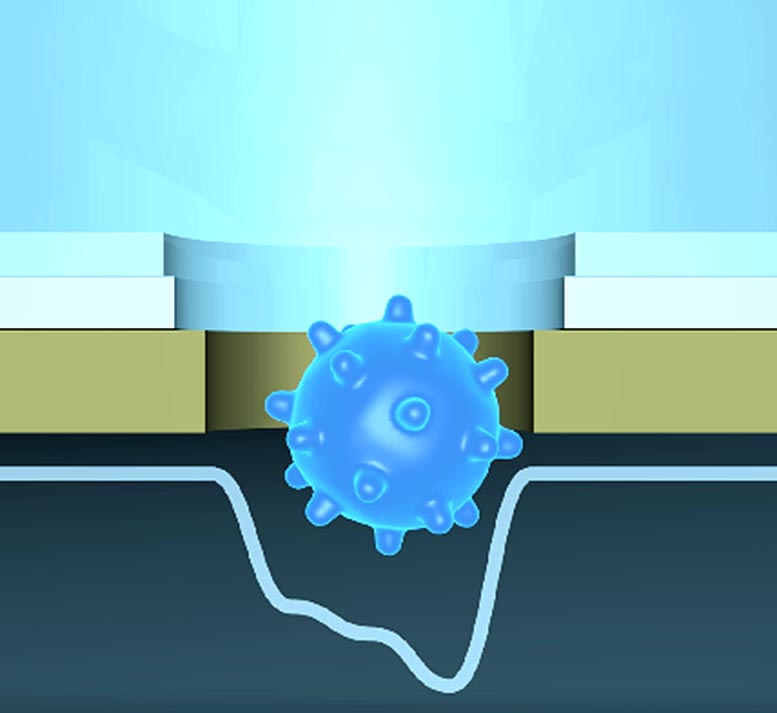Passing the COVID Test in Just Five Minutes
0 View
Share this Video
- Publish Date:
- 21 June, 2021
- Category:
- Covid
- Video License
- Standard License
- Imported From:
- Youtube
Tags

Working principle of artificial intelligence nanopore for detecting coronavirus. Credit: Osaka UniversityOsaka University
Osaka University researchers are developing a new, highly sensitive test for the SARS-CoV-2 virus that uses a combination of artificial intelligence and nanopore technology to enable rapid point-of-care testing for COVID.
A team of scientists led by SANKEN (The Institute of Scientific and Industrial Research) at Osaka University has shown that individual virus particles passing through a nanopore can be accurately identified using machine learning. The testing platform they created was so sensitive that the coronaviruses responsible for the common cold, SARS, MERS and COVID could be distinguished from each other. This work could lead to rapid, portable and accurate screening tests for COVID and other viral diseases.
The global coronavirus pandemic has highlighted the critical need for rapid pathogen screening. However, the current gold standard for detecting RNA viruses — including SARS-CoV-2, the virus that causes COVID — is reverse transcription polymerase chain reaction (RT-PCR) testing. While this method is accurate, it is relatively slow, hindering the timely interventions needed to bring an outbreak under control.
Now, scientists led by Osaka University have developed an intelligent nanopore system that can be used for the detection of SARS-CoV-2 virus particles. Using machine learning methods, the platform can accurately distinguish between similarly sized coronaviruses responsible for different respiratory diseases. “Our innovative technology has high sensitivity and can even electrically identify individual virus particles,” says first author Professor Masateru Taniguchi. Using this platform, the researchers were able to achieve a sensitivity of 90% and a specificity of 96% for SARS-CoV-2 detection in just five minutes using clinical saliva samples.
To fabricate the device, nanopores as small as 300 nanometers in diameter were drilled into a silicon nitride membrane. When a virus was pulled through a nanopore by the electrophoretic force, the opening was partially blocked. This temporarily reduced the ion current in the nanopore, which was detected as a change in the electrical current. The current as a function of time provided information about the volume, structure and surface charge of the target to be analyzed. However, to interpret the subtle signals, which can be as small as a few nanoamperes, machine learning was required. The team used 40 PCR-positive and 40 PCR-negative saliva samples to train the algorithm.
“We expect this study will enable rapid point-of-care and screening testing for SARS-CoV-2 without the need for RNA extraction,” explains Professor Masateru Taniguchi. “A user-friendly and non-invasive method like this is better suited for immediate diagnosis in hospitals and screening in places where there are large crowds.” The complete test platform consists of server-based machine learning software, a portable high-precision current measurement instrument and cost-effective semiconductor nanopore modules. By using a machine learning method, the researchers expect this system to be adapted for use in the detection of emerging infectious diseases in the future. The team hopes this approach will revolutionize public health and disease control.
Reference: “Combining machine learning and nanopore construction creates an artificial intelligence nanopore for coronavirus detection” by Masateru Taniguchi, Shohei Minami, Chikako Ono, Rina Hamajima, Ayumi Morimura, Shigeto Hamaguchi, Yukihiro Akeda, Yuta Kanai, Takeshi Kobayashi , Wataru Kamitani, Yutaka Terada, Koichiro Suzuki, Nobuaki Hatori, Yoshiaki Yamagishi, Nobuei Washizu, Hiroyasu Takei, Osamu Sakamoto, Norihiko Naono, Kenji Tatematsu, Takashi Washio, Yoshiharu Matsuura and Kazunori Tomono, June 17, 2021, Nature Communications.
DOI: 10.1038/s41467-021-24001-2










